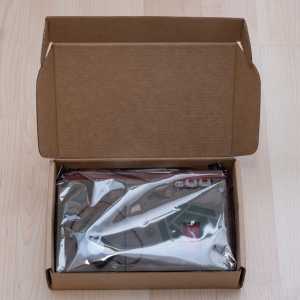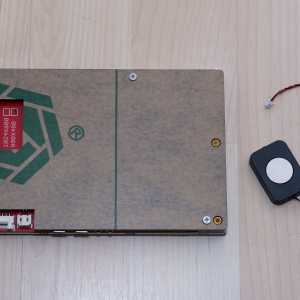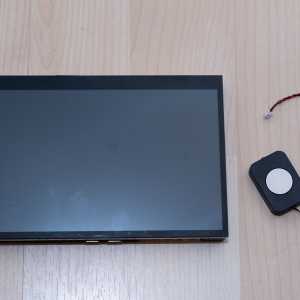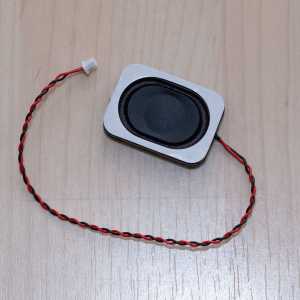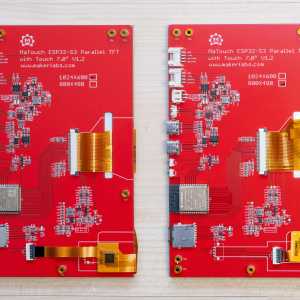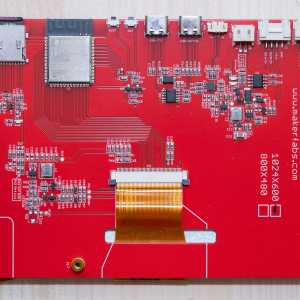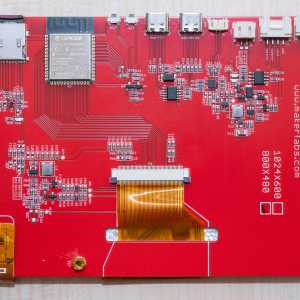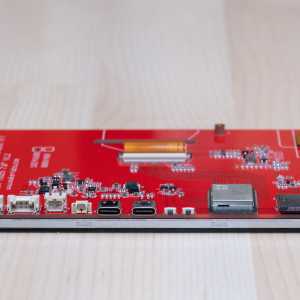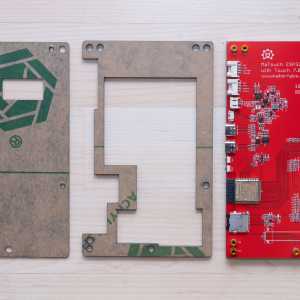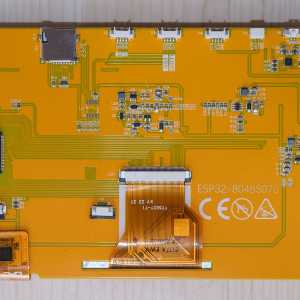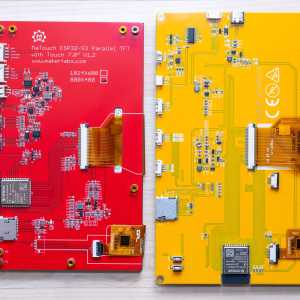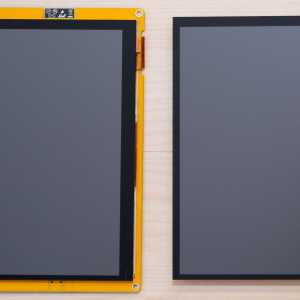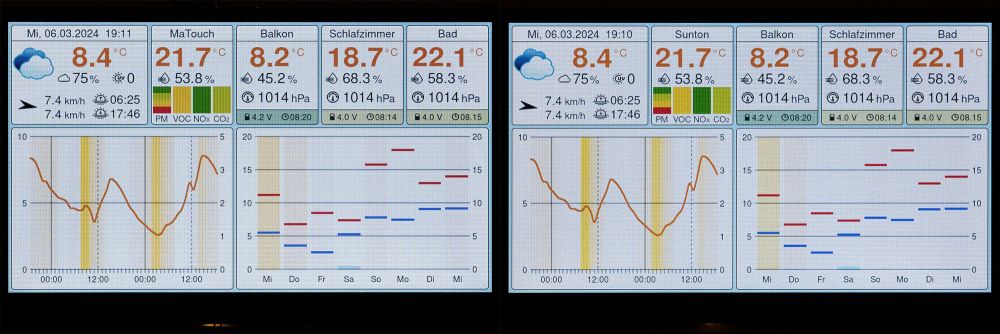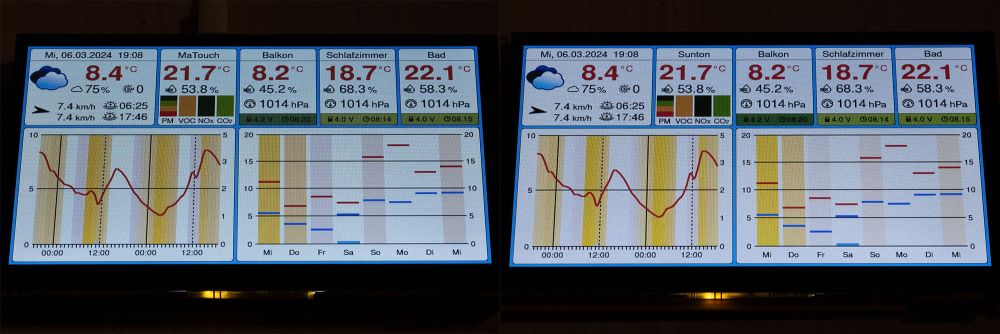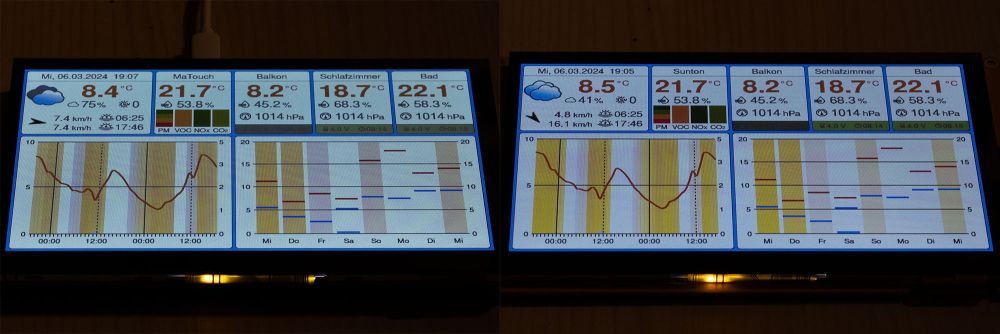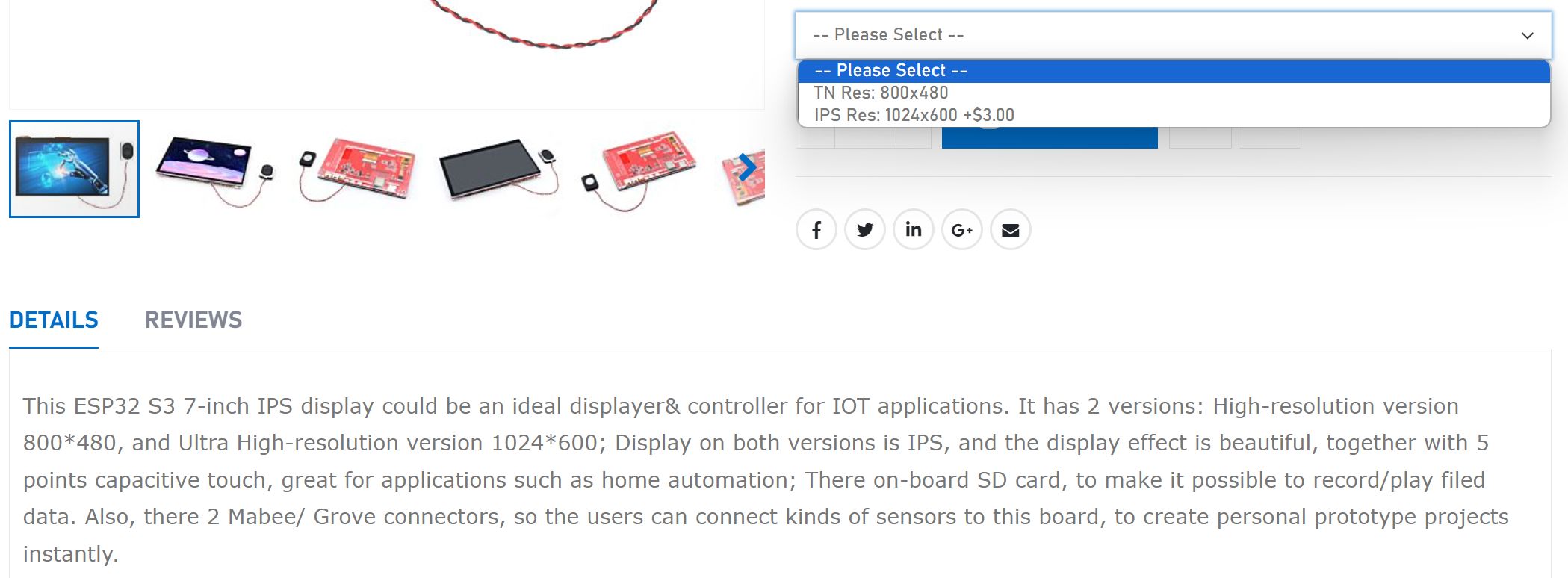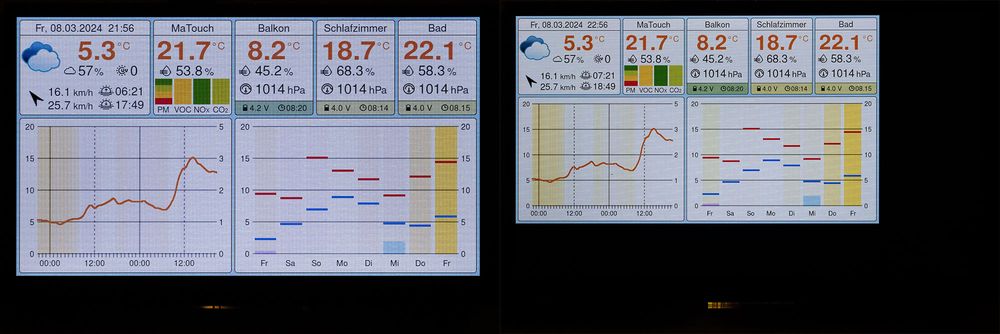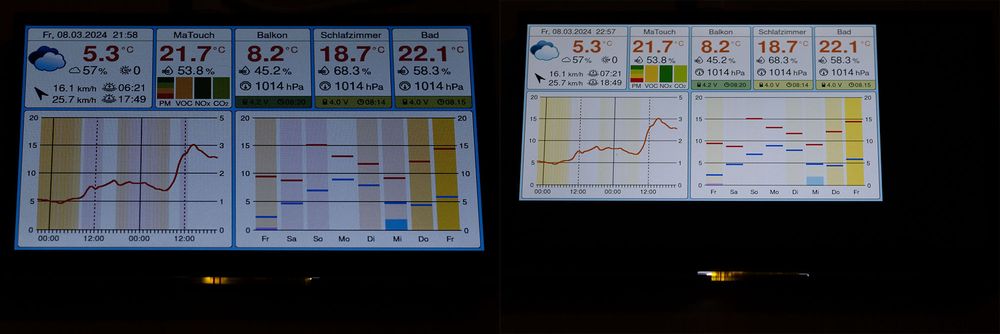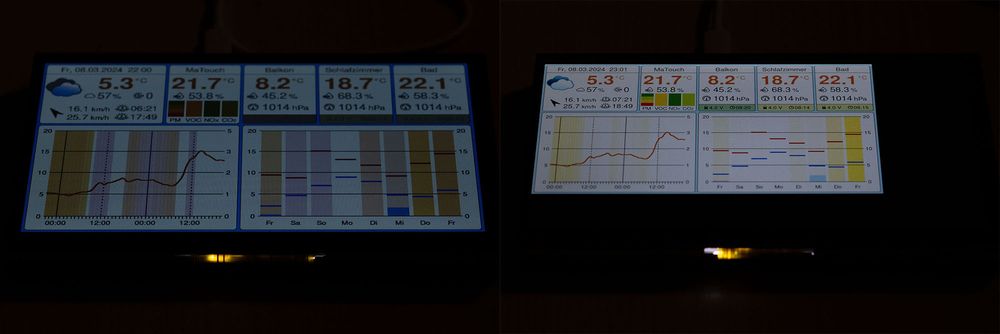First impressions of the new Makerfabs MaTouch ESP32-S3 7-inch IPS displays
Makerfabs have recently launched a new 7 inch display with an IPS panel and an ESP32-S3 microcontroller. The display is available in two different resolutions and could be described as a kind of improved version of the popular Sunton display that I described a few months ago. In this article, I would like to introduce you to the two variants of the display and highlight the differences to the Sunton display.
The MaTouch ESP32-S3 7-inch IPS display
The Makerfabs display has a number of features that make it ideal for IoT applications. With its 7-inch display, it offers enough space for complex user interfaces or extensive dashboards. The powerful ESP32-S3 from Espressif is used as the microcontroller. The board also offers a MicroSD card slot, a Class D amplifier for audio output, several I/O ports and two USB ports. Until then, however, it hardly differs from the Sunton display. The special feature of this display is the IPS panel. This means that the display should offer greater viewing angle stability, better colour reproduction and higher contrast than TN panels, which are otherwise used in displays in this price range. Another special feature is that the display is available in two resolutions. A High Density version with 800*480 pixels and an Ultra High Density version with 1024*600 pixels.
Here are the most important features of the display:
- ESP32-S3-WROOM-1 with 512 KB SRAM, 16MB Flash and 8MB PSRAM
- Power supply via USB-C, power consumption over 600 mA
- IPS panel with two resolutions: 800*480 (HD), 1024*600 (UHD)
- Parallel RGB565 LCD interface, i.e. 25 x 26 x 25 = 65536 colours
- Capacitive 5-point touchscreen with GT911 touch panel driver
- Dual USB-C (one for USB-to-UART and one for native USB)
- Mabee interfaces: 1 x I2C (IO 17 & IO 18); 1 x GPIO (IO 19 & IO 20)
- MicroSD card slot with 16MB memory card
- MAX98357A Class D amplifier (3.2 W at 4 Ω)
- Connection for lithium-ion battery and TP4056 charge controller
The last point is strangely not mentioned anywhere on the Makerfabs website. However, the charge controller is shown in the circuit diagram of the display.
Comparison of the MaTouch displays with the Sunton display
The following pictures give an impression of the MaTouch display, also in comparison to the Sunton display:
As you can see, the HD and UHD versions are visually completely identical. Only the connection for the touch sensor is in a different place. However, both versions use the GT911 as the driver. The following aspects stand out in comparison to the Sunton display:
- The MaTouch board is the same size as the display, while the Sunton board is slightly larger. This means that the casing can also be designed to be slightly more compact.
- All connections are located on one side of the MaTouch.
- The displays of the MaTouch and the Sunton Board appear completely identical on the outside.
- The Sunton display uses standard JST SH 1.25mm connectors for the I/O ports. Makerfabs uses so-called Mabee connectors. I have no idea where to buy such connectors or suitable crimp contacts.
- Neither display has a connection for the 5 volt power supply. The Sunton board at least has a soldering pad with 5 volts on the board to which you can solder a cable. The MaTouch offers nothing of the sort. Although there is a soldering pad labelled VPWR, only 4.4 volts are available here.
- The back of the MaTouch display is protected by two plastic plates. However, it is not transparent Plexiglas as shown in the photos on the Makerfabs website.
- In addition to the display, only a small speaker is included in the scope of delivery. The Sunton display also comes with a USB cable and a matching JST connector.
- The new Makerfabs displays cost $45.90 and $48.90. The Sunton board is no longer available from Makerfabs, but you can get it on AliExpress for around $45.56 and €36.05 respectively.
Documentation for the display can be found in a wiki or on GitHub. There are also some example programmes on how to use LVGL and LovyanGFX with the display. In a second article, I will go into more detail on how to create a user interface for the MaTouch display using only LVGL, without any GFX library.
MaTouch IPS panel versus Sunton TN panel
The reason why I noticed this display in the first place is the IPS panel. The viewing angle dependency of the Sunton TN panel really bothers me, as the weather station also depends on the brightness of the colour bars, and this brightness changes a lot depending on how you look at the display. However, this problem should no longer exist with an IPS panel. To check this, I installed the weather station software on both displays and photographed the screen from different angles. The camera settings were identical on all pictures. However, I had to increase the brightness of the MaTouch display slightly, as it is darker than the Sunton display, but the comparison photos should have the same brightness. For this test, I used the MaTouch display with 800*480 pixel resolution, as the weather station is optimised for this resolution.
Here are the photos. On the left is the MaTouch board, on the right the Sunton board. In the oblique view, I have corrected the exposure slightly upwards, as the brightness decreases considerably. Click on the image to see a larger version.
To be honest, I didn't really know what to make of this result. The new MaTouch display is just as dependent on the viewing angle as the Sunton display. I would have expected much more from an IPS panel. Or is it not an IPS panel at all? The description on the Makerfabs website is clear:
This ESP32 S3 7-inch IPS display could be an ideal displayer& controller for IOT applications. It has 2 versions: High-resolution version 800*480, and Ultra High-resolution version 1024*600; Display on both versions is IPS, and the display effect is beautiful, together with 5 points capacitive touch, great for applications such as home automation...I then wrote to Makerfabs and told them my findings, asking them to contact a technician to find out what kind of panel was being used. I received the following reply the very next day:
- The MaTouch 7-inch display was introduced due to negative feedback on the quality of the previous Sunton version. The Sunton display is produced in a different factory and Makerfabs was only the distributor. The MaTouch display offers better quality but at a higher cost.
- The MaTouch 7-inch display comes in two versions: one with the same display as Sunton and another with an IPS panel and higher resolution (1024*600). This decision was made to cater for different customer preferences and applications.
- The product page has been updated to clarify that the higher resolution version is IPS, while the standard version (800*480) is TN.
A very interesting answer. Makerfabs has indeed changed the website a little, but only the drop-down menu for the shopping cart. The description still states that both displays have an IPS panel.
But now for real: TN panel versus IPS panel
With this in mind, it is sufficient to compare the two MaTouch displays to illustrate the difference between the two panel technologies. The TN panel is shown on the left and the IPS panel on the right. As the user interface of the weather station is cut to 800*480 pixels, the IPS panel does not fill the entire screen. However, this is not important for a comparison. Here are the photos again::
Now you can clearly see the difference between a TN panel and an IPS panel. The colours and contrast also remain stable from the side. Only the brightness decreases, but not as much as with the TN panel. I am really impressed with this display. The display is very sharp and shows beautiful colours.
Conclusion
My final verdict on the two displays is pretty mixed. The display with the 800*480 pixel resolution and TN panel is in fact no different from the Sunton display. Fortunately, I haven't yet noticed any quality defects in the Sunton display. What I don't like at all are the Mabee connectors used. Makerfabs probably wants to promote its own sensors, as they all use this type of connector. But I prefer JST connectors, simply because I have all kinds of them in stock.
The display with the 1024*600 pixel resolution and IPS panel unfortunately has the same disadvantage. However, the panel has completely convinced me. The weather data is optimally displayed. But there is still the problem with the missing 5 volt connection for the Sensirion sensors. This problem is admittedly very specific, but unfortunately I can't build a version of the weather station with this display because of it. Of course, I could solder a cable to some component that carries the 5 volts, but I don't particularly like this solution.
Nevertheless, I clearly recommend the UHD version of the display, especially as it only costs 3 dollars more. The ESP32-S3 doesn't reach such high frame rates with it, but in my opinion this doesn't play a major role in the IoT sector. By the way, the two versions are completely identical in terms of software development. This means that exactly the same ESP32-S3 pins are used in both versions. You only have to adapt the values for the X and Y resolution to the specific display. As mentioned above, the programming of parallel RGB displays will be discussed in detail in another article.
